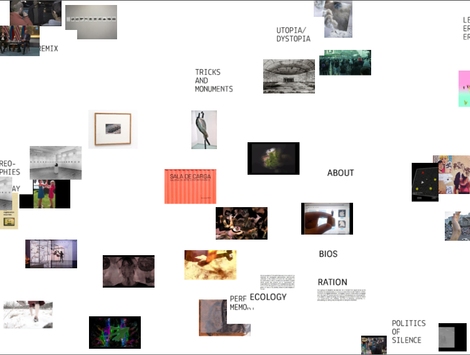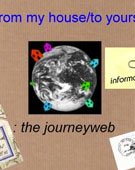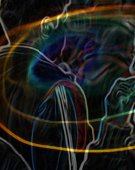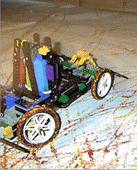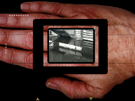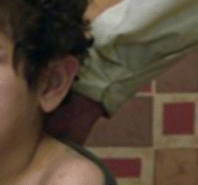DEL+REW is a digital exhibition providing a space for dialogue between different modes of artistic production engaging with the topic of Erasure and Aftermath. It is an experimental platform fostered by an ecological understanding of art and politics. The potential of the digital space to create associations and transversal alliances between actors and events is enacted through the dynamic composition of the webpage. It is ever shifting and changing, inviting visitors to navigate it, to add to its growth and further articulation.
Full Description
At the end of January 2014, we, a group of postgraduate students at Goldsmiths, University of London, sent out an open call for creative works engaging with the topic of erasure and aftermath. Over 40 artists from around the world submitted for the exhibition and approached the proposed set of questions in many different ways, enacting them through their work in various media. In close collaboration with a webdesigner, we gradually developed the digital platform which now hosts these works and provides the ground upon which new relations between them can constantly emerge. Navigators who enter the space can drag and drop the artworks, rearranging them differently. Visitors can also upload their own contents and add to the growth of the ecosystem. During the process of setting the conditions of the living exhibition, we drew inspiration from the writings of Félix Guattari and Pierre Huyghe's work. They helped us imagine an exhibition as an experiment, an exhibition as the practical work of cartographing, of conjuring new types of social relations. Since its online release on 27/03/2014, we are neither organising nor safe-guarding the space. Its initial composition as proposed by the former curators has been reshuffled multiple times, each visit of DEL+REW thus revealing the emergence or dispersal of constellations. This dynamic maps the relationships between strange actors and interests across twisted territories and times.
Work metadata
- Year Created: 2014
- Submitted to ArtBase: Thursday May 29th, 2014
- Original Url: http://www.delrew.com/
-
Work Credits:
- Aurore Bano, Francesca Borgonovo, Neda Genova, Julie Kim, Caroline Trotman, co-curators
- R., webdesign
- Ada Avetist, Elisa Bailey, Liam Baulch, Jóhanna Björk & Karina Hanney, Sarah Boulton, Varinia Canto Vila, Alex Chevalier, Sarawut Chutiwongpeti, Peter Ciccariello, Franck Guarinos, Constance Humphries, Cristian Inostroza & Paula Urizar, Youngshin Jeon, Michaela Lakova, Mauri Lehtonen, Jan Lemitz, Leonardo Liccini, Daniel Mann Blake McConnell, Tristan McNeil, Rebecca Merrill, Evan Merz, Bijan Moosavi, Nikolay Nikolov, Aaron Oldenburg, Roberta Orlando, Francisco Papas Fritas, Bertrand Pithioud, Jean-Michel Rolland, Sala de Carga Gallery, Jens Schmidt, Guli Silberstein, Balam Soto, Celia Stroom, Neasa Terry, Nicholè Velásquez, Ellen Wetmore, Shen Xin, Maria Yashchanka, Marat Zakirov and Ventsislav Zankov., artists
- Collective: DEL+REW
Take full advantage of the ArtBase by Becoming a Member
Artist Statement
“Not even nothing is free of ghosts” - K. Barad
When we see pictures and videos of forcefully emptied out places such as Tahrir Square, Gezi Park, Euromaidan or even the Favela Café at ArtBasel, we encounter the sites of struggle and protest that faced their own destruction. Being themselves ruptures or negations of certain conceptions of order, reality or normality, these spaces are subject to another type of negation. The violent clearings bare witness to the desire of the policing state to do away with dissensus and struggle in an absolute, irreversible manner. Nevertheless, for all the cleansing and purifying desires that provoked the evacuations, these spaces are haunted by the events that preceded such actions and that remain entangled with their present. Their emptiness and vacancy are not part of a smooth transition from one state of order to another. They are rather fractured and wounded by that same order which they try to defy; the tranquility of the aftermath is full of horror, desire, suppressed struggles and unexpressed fears.
“The quiet cacophony of different frequencies, pitches, tempos, melodies, noises, pentatonic scales, cries, blasts, sirens, sighs, syncopations, quarter tones, [...] are threaded through the silence, ready to erupt, but simultaneously crosscut by a disruption, dissipating, dispersing the wouldbe sound into non/being, an indeterminate symphony of voices. [...] A jubilation of emptiness.” (K. Barad)
Is there a way we can sound out the presence of all the reverberating cries and whines that continue into the future, piercing through the silence of the present? The jubilation of emptiness can be the site of unfolding a potential for other, more “inhabitable narratives” (D. Haraway) of the future, but it can also be the paralyzing gesture of celebrating order and tranquility. In our project, we tried to occupy once more that moment of erasure and negation and explore it in its multiple temporal entanglements (suspended between past and future, between the necessity of bearing witness and the potential for change) as well as in its dependencies on power and institutional relations. If, as Bergson puts it, negation is more than what it negates, if it entails this something as well as the operation – generalized and particular – of negation itself (G. Deleuze, Bergsonism), how can we make sense of the act of erasure? Is erasure the scar of a cleansing operation or is it itself marked by frictions and traces that could be touched upon? Where do we have to position ourselves in order to be able to hear the quarter tones of past events resonating the aftermath?
